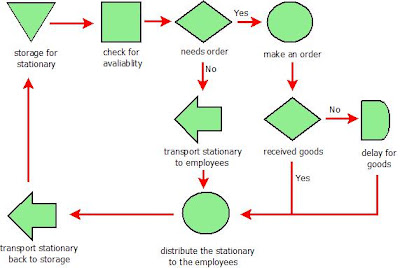Popular Posts
-
Tesco develops a buy-side e-commerce system for supply chain management 1) What benefits does Tesco’s information exchange offer to the r...
-
Background of the Company E-bay is a site that commenced trading on Monday, 4 September 1995 with name 'Auction Web'. The sit...
-
PROCUREMENT: Procurement is more than the steps that are used in the acquisition of goods and services. E-Procurement makes sure that produc...
-
CUSTOMER RELATIONSHIP MANAGEMENT CRM, or Customer Relationship Management, is a company-wide...
Sunday, November 28, 2010
Friday, November 26, 2010
Redesigning a process
PROCUREMENT:
Procurement is more than the steps that are used in the acquisition of goods and services.
E-Procurement makes sure that product should be in right price, good quality and in proper quantity. It need the product should be delivered in the right time from the source.
CURRENT STATE:
In the current state the stationery are stored in the storage. The company will check for the availability of the stationery for employers. If they have enough stationery they will be transported from the storage to the employees and it has to be distributed to the employees. Suppose there is not enough stationery in the storage they have to make an order for the new stationery. If the goods are received in time they need to be distributed to the employees else they need to wait for the stationery. The remaining stationeries are transported back to the storage.
RE-DESIGN STATE:
In the new state the stationeries are stored and database is developed for the storage. The inspection is made to check for the availability of the stationery. The check for employee needs is done by the company. If the company has enough stationery with them they will transport the stationery to the employees. Instead if they don’t have enough stationery with them, they will search for the better product for the employees and make order for them. If the goods reached in time they will be transported for the employees. If else there will be a delay in goods. So company make arrangement for make the goods to deliver in time. These new goods will be updated in the storage database. Finally these goods will be distributed to the employees and get feedback from the employees. The remaining stationeries will be transported back to the storage
Tesco develops a buy-side e-commerce system for supply chain management
1) What benefits does Tesco’s information exchange offer to the retailer and its supplies?
- Tesco's information exchange server offers a sophiscated two-way collaboration in its supply chain.
- It shifts the responsibility of managing products down to the relevant supplier because they have access to almost real time data of Tesco's products from the stores or depots.
- It ensures products availability, reduces Tesco's inventory cost and also the suppliers inventory cost.
- It makes understanding of specific products between Tesco and its suppliers easier.
2) What differences have the use of TIE added over the original EDI system?
- The Tie system provides real time products information to see how sales perform by distribution centre, by individual store or even by TV region- important for promotions.
- The Tie system also facilitated a two-way collaboration in Tesco's supply chain unlike the EDI. The EDI only forecasts demands of products and messages of actual store demand or depot are sent to the relevant supplier.
3) Discuss reasons why only two of Tesco’s suppliers have fundamentally altered the way they work as a TIE.
1. The suppliers will be providing products to other retailers who may not be using a TIE exchange system as Tesco has. So the suppliers have to keep using the same work line to satisfy all their retails.
2. Retailing is one of the traditional industries, where each of the supplier must follow their own work line that suits the needs for the majority of the retailers.
Who manages the supply chain?
Advert 1: Supply chain manager- The Healthcare Company
Responsible for: provide strategic and tactical leader-ship to the UK operation, reinforcing customer service and delivering supply chain profitability; instrumental in developing and implementing supply chain; be the ambassador of customer service and supply chain.
Skills: outstanding communication and influencing skills; combined with excellent analytical skills.
Experience: a thorough working knowledge of IT business management tools.
Advert 2: Supply chain manager- The Manufacturing Company
Responsible for: the design and implementation of information flows; manage trade-off between production efficiency, inventory and customer service; analysis of data to ensure that valid business decisions; management of service level agreements to maximize service whilst minimizing inventory; championing the use of IT planning systems; the development of team members to ensure standards are set and achieved.
Skills: analytical and problem-solving skills; strong system knowledge in planning and inventory control preferably in a short lead-time environment; highly motivated with strong influencing and communication skills.
Experience: been educated to a high standard, ideally with a relevant degree; strong system experience in planning and inventory control preferably in a short lead-time environment.
Advert 3: Logistics manager- The Engineering Company
Responsible for: the business, coordinating activities between operations and function; measured by the achievement of positive change in continuous improvement environment; involve direct control of distribution and third parties.
Skills: outstanding communication and high influencing skills.
Experience: graduate caliber from a background involving commercial and budget responsibility, customer-focused with character, drive and energy.
Advert 4: Transport manager- The Food Manufacturer
Responsible for: efficient distribution operation
Skills: analytical and planning
Experience: extensive transport and management
Subscribe to:
Comments (Atom)





